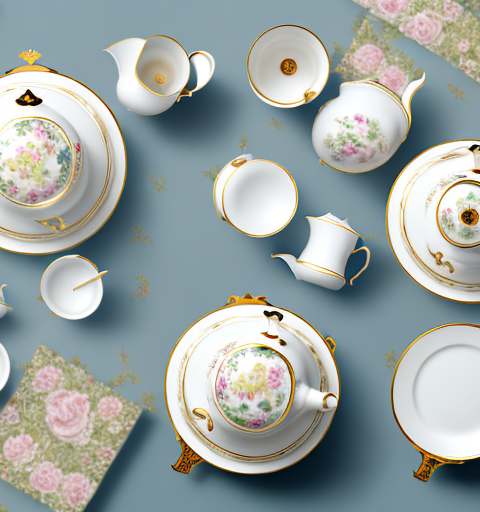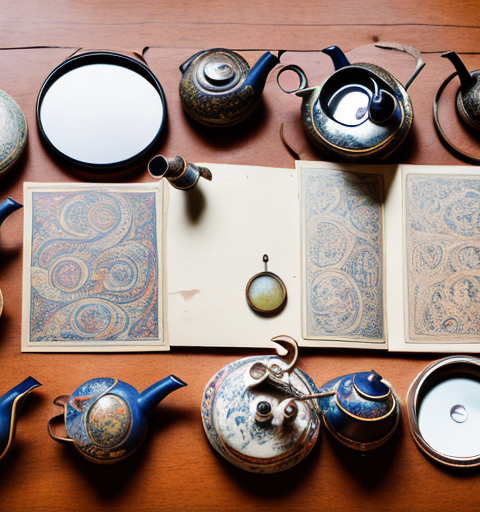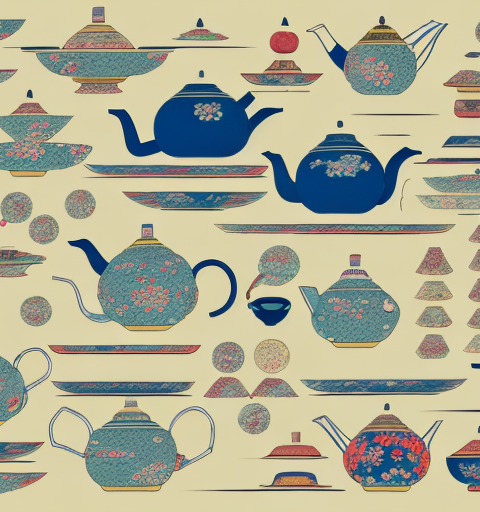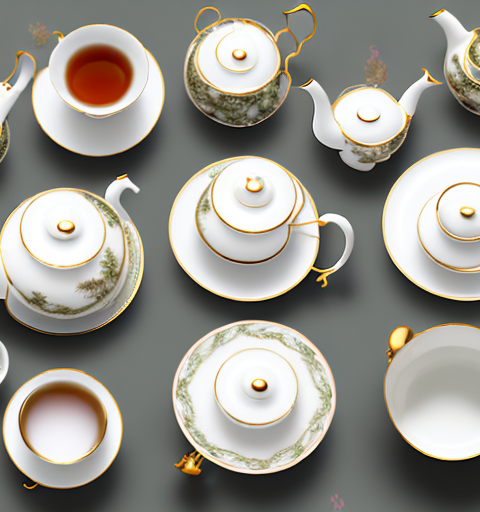Antique teapots hold a certain charm and allure that captivate collectors, tea enthusiasts, and history buffs alike. Their intricate designs, rich history, and cultural significance make them captivating pieces of art that are sought after by avid collectors around the world. In this article, we will delve into the world of antique teapots, exploring their history, understanding their value, and providing you with the knowledge to identify and care for these treasured artifacts.
The History of Teapots
Teapots have a long and fascinating history, with their origins dating back centuries. The invention of teapots can be traced to ancient civilizations such as China, where tea first originated. Early teapots were made of simple clay, and their designs evolved over time, reflecting the cultural and artistic influences of different eras.
Early Origins of Teapots
The earliest known teapots can be traced back to the Yuan Dynasty in China, around the 13th century. These early teapots were small and simplistic, primarily made of earthenware and used for brewing and serving tea. As tea drinking gained popularity, so did the demand for more elaborate and aesthetically pleasing teapot designs.
During this period, tea was not only consumed for its taste but also for its medicinal properties. The teapots used were carefully crafted to ensure the proper brewing and infusion of the tea leaves, allowing the drinker to fully experience its healing benefits. The clay used in these teapots was believed to enhance the flavor and aroma of the tea, making each cup a truly sensory experience.
As trade routes expanded and tea became more widely available, the demand for teapots grew. Artisans began to experiment with different shapes and sizes, incorporating decorative elements that showcased the craftsmanship of their work. Teapots became not just functional objects but also works of art, reflecting the cultural and artistic trends of the time.
Evolution of Teapot Designs Through the Ages
With the rise of the Ming Dynasty, teapot designs became more refined and intricate. Artisans began experimenting with different materials, such as porcelain and later silver and copper, to create teapots that were not only functional but also visually appealing.
During this period, tea drinking became a highly ritualized practice, with elaborate tea ceremonies being performed by the upper classes. Teapots played a central role in these ceremonies, symbolizing elegance, refinement, and social status. The designs of the teapots became more elaborate, incorporating intricate motifs, delicate handles, and spouts in the shape of animals or mythical creatures.
Teapots became highly sought after by the upper classes, and their production became a symbol of status and wealth. Skilled artisans dedicated themselves to perfecting the art of teapot making, and their creations were highly prized. These teapots were often passed down as family heirlooms, treasured for their beauty and historical significance.
As the Qing Dynasty came into power, teapot designs continued to evolve, reflecting the changing tastes and influences of the time. The Manchu rulers brought with them a new aesthetic, blending traditional Chinese elements with their own cultural heritage. Teapots during this period often featured intricate engravings and vibrant colors, showcasing the craftsmanship and attention to detail that went into their creation.
Today, teapots continue to be an integral part of tea culture around the world. From traditional designs that pay homage to the rich history of tea drinking to modern interpretations that push the boundaries of form and function, teapots remain a beloved and cherished item for tea enthusiasts everywhere.
Understanding Antique Teapots
Before diving into the intricate world of antique teapots, it is essential to define what constitutes an antique teapot and explore the different types available.
Defining ‘Antique’ in the Context of Teapots
An antique teapot is generally considered to be a teapot that is at least 100 years old, although some collectors may define it as a teapot that is over 50 years old. However, the age alone does not determine the value of an antique teapot; other factors such as rarity, craftsmanship, and historical significance also play crucial roles.
When determining the age of an antique teapot, collectors often rely on various methods such as examining the maker’s mark, researching historical records, and consulting experts in the field. These teapots hold a tangible connection to the past, carrying with them the stories and memories of the people who once used them.
Different Types of Antique Teapots
Antique teapots come in various styles and materials, each with its own unique characteristics and value. Some common types of antique teapots include porcelain teapots, silver teapots, and Yixing teapots. Each of these types has its own distinct appeal and is highly sought after by collectors.
Porcelain teapots, known for their delicate beauty, are highly valued for their craftsmanship and intricate designs. These teapots often showcase exquisite hand-painted patterns, intricate gilding, and sometimes even rare and precious materials such as gold or precious gemstones. The artistry and attention to detail involved in creating these teapots make them true works of art.
Silver teapots, on the other hand, are sought after for their elegance and timeless appeal. Crafted by skilled silversmiths, these teapots often feature intricate engravings, embossed patterns, and sometimes even ornate handles and finials. The reflective surface of silver teapots adds a touch of sophistication to any tea-drinking experience.
Yixing teapots, originating from China, are known for their unique clay composition and are revered for their ability to enhance the flavor and aroma of tea. Made from a special type of clay found only in the Yixing region, these teapots are believed to absorb the essence of the tea over time, resulting in a more flavorful and aromatic brew. The simple yet elegant designs of Yixing teapots reflect the Zen philosophy of tea appreciation.
Collecting antique teapots can be a fascinating journey into the history of tea and the cultures that have cherished this beverage for centuries. Each teapot tells a story, and each collection is a testament to the passion and dedication of the collector. Whether you are a seasoned collector or just starting your exploration, the world of antique teapots offers a treasure trove of beauty, craftsmanship, and historical significance.
Factors That Determine the Value of Antique Teapots
When determining the value of an antique teapot, several factors come into play. These factors can significantly impact the desirability and price of a teapot among collectors.
Age and Rarity
Naturally, the age of an antique teapot is a crucial factor in its value. Older teapots tend to be more valuable, especially if they are rare or from a specific historical period. Teapots from renowned artists or kilns are often highly sought after by collectors and can fetch significant prices.
For example, a teapot from the Song Dynasty, dating back to the 10th century, would be considered extremely rare and valuable. The craftsmanship and artistry of teapots from this era are highly admired, making them highly coveted among collectors.
Similarly, teapots from famous artists like Josiah Wedgwood or Meissen porcelain teapots from the 18th century are known for their exceptional quality and rarity. These teapots often become the centerpiece of teapot collections and can command top prices at auctions.
Condition and Restoration
The condition of an antique teapot greatly affects its value. Teapots that are in excellent condition, free from cracks, chips, or repairs, are more valuable than those with visible damage. While minor restoration work may not diminish the value significantly, extensive repairs or alterations can detract from a teapot’s worth.
Collectors prefer teapots that have retained their original form and features. A teapot with its original handle, spout, and lid will generally be more valuable than one with replaced parts. Additionally, teapots with intact and vibrant glazes or intricate hand-painted designs are highly sought after.
Some collectors even specialize in restoring antique teapots to their former glory. These experts meticulously repair and clean teapots, ensuring that they regain their original beauty without compromising their value. However, it is essential to note that restoration should be done by professionals to avoid any damage that could decrease the teapot’s value.
Provenance and Historical Significance
The provenance, or the documented history of a teapot, can greatly influence its value. Teapots with a noteworthy historical background, such as those owned by famous individuals or associated with significant events, can command higher prices due to their historical significance.
For instance, a teapot that once belonged to a notable historical figure like Queen Victoria or George Washington would undoubtedly be highly valuable. The connection to such influential personalities adds a layer of historical importance, making the teapot a prized possession for collectors.
Teapots associated with significant events or cultural movements can also attract considerable attention. For example, a teapot used during a famous tea ceremony or a teapot representing a particular artistic style or movement can be highly sought after by collectors who appreciate the cultural and historical significance.
In conclusion, when evaluating the value of an antique teapot, factors such as age, rarity, condition, restoration, provenance, and historical significance all play a vital role. Collectors carefully consider these factors to determine the desirability and price of a teapot, making the world of antique teapot collecting a fascinating and intricate realm.
How to Identify Valuable Antique Teapots
Identifying a valuable antique teapot can be a thrilling adventure filled with intrigue and discovery. Knowing what to look for and the telltale signs of a valuable teapot can greatly enhance your collecting experience.
As you embark on your journey to identify valuable antique teapots, it is essential to recognize the marks and signatures that often adorn these treasured pieces. Many antique teapots bear marks or signatures that indicate the maker, artist, or origin of the teapot. These marks can provide valuable information about the teapot’s history and help authenticate its age and craftsmanship.
Researching and familiarizing yourself with these marks can be invaluable when identifying valuable teapots. For example, the renowned Wedgwood pottery company often marked their teapots with their iconic stamp, consisting of the company name and sometimes a date code. Similarly, the famous Meissen porcelain factory in Germany used various marks throughout its long history, including crossed swords, which became synonymous with their exquisite craftsmanship.
However, it is important to note that not all antique teapots have visible marks or signatures. Some teapots may have had their marks worn away over time or were simply never marked by their makers. In such cases, other factors come into play when determining their value.
Assessing Quality and Craftsmanship
While marks and signatures can provide valuable insights, the quality of a teapot’s craftsmanship is a crucial aspect when determining its value. When examining a teapot, pay close attention to the details. Look for teapots with precise details, well-balanced proportions, and flawless finishes.
Consider the materials used in the teapot’s construction. Fine porcelain teapots, known for their delicate beauty, are highly sought after by collectors. The translucent quality of porcelain allows the light to pass through, giving the teapot an ethereal glow. Silver teapots, on the other hand, exude elegance and sophistication. The craftsmanship involved in creating silver teapots, with their intricate engravings and ornate handles, adds to their allure.
As you assess the craftsmanship, also take note of any decorative elements on the teapot. Elaborate hand-painted designs, intricate relief work, or delicate gilding can significantly enhance a teapot’s value. These decorative elements showcase the skill and artistry of the teapot’s creator, making it all the more desirable for collectors.
Furthermore, examine the teapot’s condition. While minor wear and tear can be expected due to age, teapots in excellent condition will generally command higher prices. Look for teapots with minimal damage, such as chips, cracks, or repairs, as these imperfections can detract from the teapot’s value.
When evaluating the quality and craftsmanship of a teapot, it is important to consider the overall aesthetic appeal as well. A teapot that possesses a unique and captivating design, whether it be a whimsical shape or an innovative handle, can captivate collectors and drive up its value.
By understanding the importance of marks and signatures, as well as assessing the quality and craftsmanship of a teapot, you can become a skilled detective in the world of antique teapot identification. So, embark on your adventure, armed with knowledge and a keen eye, and uncover the hidden treasures that lie within these cherished artifacts.
Where to Buy and Sell Antique Teapots
Once you have delved into the world of antique teapots and identified the models that pique your interest, the next step is to find the perfect place to buy or sell these exquisite pieces. Antique teapots hold a rich history and charm that can add a touch of elegance to any collection or tea party. Whether you are a seasoned collector or a novice enthusiast, exploring the various avenues for buying and selling antique teapots can be an exciting adventure.
Antique Shops and Auctions
Antique shops and auctions are excellent places to discover a wide range of antique teapots. These establishments often have knowledgeable staff who can provide valuable insights and guidance on the teapots available. Stepping into an antique shop is like entering a treasure trove of history, where each teapot tells a unique story. The shelves are lined with teapots from different eras, showcasing the craftsmanship and artistry of the past. Antique auctions, on the other hand, offer the thrill of bidding and the possibility of finding rare or unique teapots that may not be available elsewhere. The competitive atmosphere adds an element of excitement, as collectors eagerly vie for their desired piece.
When visiting antique shops or auctions, take the time to carefully examine each teapot. Pay attention to the condition, markings, and any signs of restoration. Antique teapots that are in pristine condition or bear the signature of a renowned maker are highly sought after and may command a higher price. Engage in conversations with the staff or fellow collectors, as they may share valuable information about the teapot’s history or provenance.
Online Marketplaces
The internet has revolutionized the way we buy and sell antiques, including antique teapots. Online marketplaces such as eBay, Etsy, and specialized antique websites provide a vast selection of teapots from various sellers around the world. The convenience of online shopping allows collectors to browse through numerous options without leaving the comfort of their homes. From delicate porcelain teapots adorned with intricate floral patterns to sturdy cast iron teapots with rustic charm, the online marketplaces cater to diverse tastes and preferences.
However, it is essential to exercise caution and ensure the authenticity of the teapot and the credibility of the seller before making a purchase. Look for detailed descriptions and high-resolution images that showcase the teapot from different angles. Read customer reviews and check the seller’s reputation to gauge their reliability. Authenticating antique teapots can be a complex process, so it is advisable to consult experts or refer to reputable reference books to verify the teapot’s origin and age.
Additionally, online marketplaces often provide a platform for collectors to connect and share their knowledge. Participating in forums or online communities dedicated to antique teapots can be a valuable resource for learning about the latest trends, discovering hidden gems, and connecting with fellow enthusiasts.
Caring for Your Antique Teapots
Owning antique teapots comes with the responsibility of proper care and maintenance to preserve their beauty and value for future generations.
Cleaning and Maintenance Tips
When cleaning antique teapots, it is crucial to use gentle methods and avoid harsh chemicals that may damage the teapot’s delicate surfaces. Handwashing with mild soap and warm water is generally recommended, along with regular dusting and polishing to maintain the teapot’s luster.
Proper Storage and Display
Storing antique teapots requires careful consideration to prevent damage. Use acid-free tissue or soft cloth to wrap teapots, and avoid stacking them to minimize the risk of chips or scratches. When displaying teapots, ensure they are placed away from direct sunlight and in a location where they are less likely to be bumped or knocked over.
Case Studies of Valuable Antique Teapots
While the world of antique teapots is filled with numerous valuable pieces, some stand out for their astonishing prices and intriguing stories.
The Most Expensive Teapots Ever Sold
One of the most notable teapots to break records is the 18th-century Qianlong-period Chinese teapot, which sold for a staggering $3 million at auction. Known for its exquisite craftsmanship and intricately detailed designs, this teapot showcases the allure and value associated with rare and exceptional antique teapots.
Hidden Gems: Unassuming Teapots with High Value
Not all valuable antique teapots bear the grandeur and opulence of those that fetch astronomical prices at auctions. Some unassuming teapots, discovered in small antique shops or flea markets, have surprised collectors with their high value. These hidden gems highlight the element of surprise and excitement that makes collecting antique teapots such a rewarding endeavor.
In conclusion, delving into the world of antique teapots is a delightful journey through history, culture, and craftsmanship. Understanding the history, value factors, and identification techniques can enhance your appreciation for these remarkable artifacts. Whether you are a seasoned collector or an aspiring enthusiast, the captivating allure of antique teapots will continue to fascinate and inspire for generations to come.






